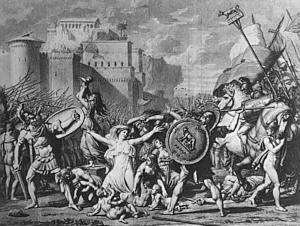We are in the early days of Roman history. The Romans have abducted the daughters of their neighbors, the Sabines. To avenge this abduction, the Sabines attacked Rome, although not immediately- since Hersilia, the daughter of Tatius, the leader of the Sabines, had been married to Romulus, the Roman leader, and then had two children by him in the interim. Here we see Hersilia between her father and husband as she adjures the warriors on both sides not to take wives away from their
husbands or mothers away from their children. The other Sabine Women join in her
exhortations.
After many preliminary compositional sketches, which occupied him for some
time, David chose to set out in a totally new direction, marking a turning point in his
artistic development. He himself explained that, finally, he had wanted "to go back
to the source" and "return art to the principles followed by the Greeks." It might
surprise us that, in view of his intention to paint a picture that was "more Greek than
the earlier ones," David chose a Roman subject. But the term "Greek Art" should be
understood here in the ideal meaning of the term.
As in his previous history paintings, David strove simultaneously for truth and
grandeur. His figures are at one and the same time human beings and heroes. He
borrowed his attitudes from classical bas-reliefs and his figures from contemporary
models. .
The most striking thing about this painting is that the warriors are nude. David
was inspired by the idea that the Greeks had represented their gods, athletes, and
heroes in the nude. David was not seeking, as had Michelangelo, for example, to
glorify masculine beauty, but rather to endow his heroes with a superior quality that,
ultimately, was more moral than physical. With the exception of Romulus, these
nude bodies are not Particularly muscular. David wanted to refine, to strip away
anything that was unnecessary, to reduce everything to a supreme, heroic simplicity.
The element that we probably find most seductive about this painting today is
the way in which David has projected and controlled the tumultuous movement of all
the figures, which he then brings to an abrupt halt. Hersilia and the other Sabine
Women really seem to be bursting onto the scene, which they dominate. In contrast,
the armies are only suggested, rather than represented, by a forest of lances, pikes,
and standards; the leader of the cavalry puts his sword back in its sheath, the horses
rear in a static, quivering motion; the two warriors who are about to clash are frozen
in their attitudes, their furious precipitation arrested as they seem rooted to the spot.
David has also tamed his colors. Of his earlier palette, he has retained only some
of the vivid reds on the shoulder of Tatius, Romulus's helmet, and the robe of the
woman behind Hersilia; elsewhere, the reds are shaded with brick-toned hues. Some
yellows, not as bright as in earlier paintings, a bit of green on the old woman's robe,
and a bit of blue near Tatius's foot recall the tones David had once preferred. In
contrast, the nude bodies, the walls of Rome, the standards and the pikes, the horse's
hide, and Hersilia's tunic make up a spectrum of clear bronzed tones under a slightly
tinted sky.
He has totally abandoned any attempt at chiaroscuro or shadow effects. The
light is everywhere. He wants to show the light as a triumphant but gentle mediatrix,
like the Sabine Women.
Return to the J. L. David page

